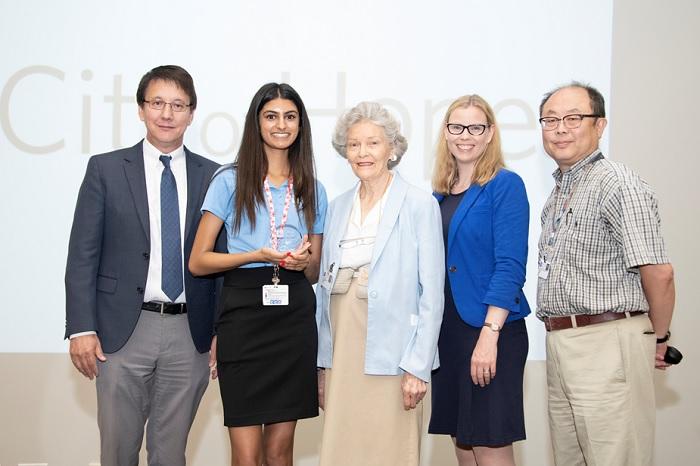Paul Salvaterra Scholar
In 2014 the Eugene and Ruth Roberts Summer Student Academy inaugurated a special award to honor Paul Salvaterra who has directed the academy program for the last 40 years.
The named award, the Paul Salvaterra Scholar, was given to the student who wrote the best essay about a scientist that he or she most admires.
David Horne, Ph.D., Karina Seth, Ruth Roberts, Kate Sleeth, Ph.D., and David Ann, Ph.D.
THE 2018 WINNING ESSAY
by Karina Seth, a rising senior at Irvine High School
The Scientist I Admire Most
In an increasingly digital world, the fields of math, science and innovation are so tightly intertwined that it becomes almost impossible to decipher between the three. At the root of these subjects lies a single revolutionary invention - the computer. Alan Turing, father of the Turing machine, propagated computer science, cryptanalysis, theoretical biology, and most notably, perseverance in the face of immoral opposition.
Turing grew up in Hastings, England, showing signs of intelligence throughout his early childhood. He attended Sherborne School, where he met Christopher Morcom, which led to Turing’s first relationship. Morcom died suddenly from tuberculosis, which drove Turing into deep depression and forced him to turn to math and science to escape his grief. Turing’s sheer genius and love for computer science shone through in all he did: at the age of 16, he read and deciphered Einstein’s works, and extracted conclusions that were previously unknown.
After finishing grade school, Turing attended King’s College in Cambridge, where he first developed the outline of the ‘Turing machine,’ a device that could perform any operation that was written algorithmically. This idea was revolutionary at the time and proved to be extremely valuable later in Turing’s life. After his graduation, World War II broke out in Europe. At Bletchley Park, Turing worked with a team of other brilliant scientists to decode the German Enigma machine, and ultimately cut the war short by two years, saving near twenty-one million lives. The Enigma machine was a complex puzzle of rotors, wiring and plugboards that encoded and protected German wartime messages. To break Enigma was to win the war.
Turing and his team transformed the Polish bomba kryptologiczna into the bombe - a highly sophisticated machine that sifted through over 1022 possible combinations of ‘cribs,’ or fragments of probable messages. Turing’s mind worked uniquely, weaving ideas and formulas into everything he did. His colleague Jack Good simplified one of Turing’s most revolutionary ideas: “from a contradiction, you can deduce everything.” It was this idea, that most settings of the Enigma machine would contradict each other and could thus be excluded, that proved to be the central dogma of the Turing machine and even modern computational devices.
Upon winning World War II, Turing moved to Hampton and designed the Automatic Computing Engine, referred to as ACE. This was known as the ‘universal computing machine,’ saturated with complex circuits and codes. Turing also began exploring artificial intelligence, a field which remains intricate and relevant. He implemented the ‘Turing test’ to determine an object’s intelligence; machines are only said to be intelligent if a human can converse with them and not realize that it is a machine. He also suggested subjecting a computer to learning experiences, similar to a child, and determining whether its capacity for knowledge is dynamic or stagnant. With ideas like these, he redefined the typical worldview of intelligence and knowledge.
Finally, Turing delved into mathematical biology, studies which culminated in his publication of “The Chemical Basis of Morphogenesis.” Here, he used Fibonacci phyllotaxis to understand the mechanism by which plants and animals develop symmetrical shapes and patterns. His work led to the eventual discovery of Hox genes
In 1952, at 39 years old, Turing was convicted of “gross indecency” due to his relationship with Arnold Murray. Because homosexuality was illegal at this time in the United Kingdom, Turing was subjected to chemical treatments that reduced his libido and rendered him sterile. Turing committed suicide through cyanide poisoning in 1954, at only 41 years old.
Alan Turing represents everything a great scientist should embody: curiosity, perseverance and a desire to better the world. I admire Turing’s intelligence, and the initiative he displayed regardless of the consequences. I chose to write about Alan Turing because he personifies everything I want to be. Aside from his striking genius, Turing had an innate love for knowledge that guided his every action. To this day, his work continues to be cited in math and science papers, and his designs and philosophies adapt to fit an ever-changing world. I admire Turing not only as a scientist, but as a person. His discoveries have profoundly impacted our world, and his resilience in the face of adversity is an inspiration to anyone who wants to learn.
